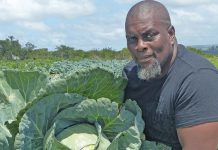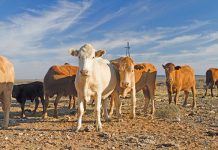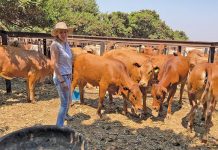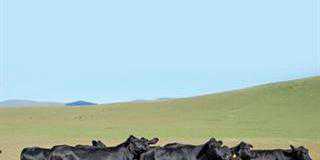
Photo: Chris Nel
The impending registration of a new livestock breed in South Africa always arouses interest. More so if the breed characteristics promise to benefit the economics of the national red meat industry.
Christiaan de Jager, a cattleman from Roedtan in Limpopo, has built up a herd of about 280 pure-bred Chianina cattle. His first production sale in October 2009 and his second in 2011 have set the scene for what may prove to be a revolution in our beef industry.
At the first sale, with no reserve and no pure-bred females on offer, 22 pure-bred bulls averaged R48 750 and at the second sale, again with no reserve, Martiens de Wet of Polokwane bought two pure-bred cows with calves for R350 000 each.
A historical perspective
Fifty years ago, Chianina cattle were a common sight in the rural landscape of Tuscany. Reputed to be the biggest cattle breed in the world and among the oldest, if not the oldest, of all pure cattle breeds, Chianina date back to the Roman Empire.
Two thousand years ago, they were used mainly for draught and sacrificial purposes. Later, during the Middle Ages, no rural peasant would have accommodated an animal that could not work well, and cows and bullocks alike were harnessed as draught animals.
Beasts who did not perform were slaughtered. This practice, an early form of selective breeding, left the Chianina with great genetic stability and uniformity.
Breeding was geared towards large, strong animals. The genetic legacy of two millennia has expressed itself in cattle with heavy muscling, long legs, hard hooves, good movement, endurance and a calm disposition.
Later the Chianina was developed as a dual purpose draught and meat breed. As machines began to replace draught animals, breeding goals shifted for improved beef production and secondary selection criteria such as length of body, milk yield and growth rate were introduced.
Taking on the world
The Chianina was little known outside Italy until the late 1960s when semen was exported to Canada. The US imported Canadian semen and in the early 1970s shipped in a load of purebred bulls. Australia too, formed the nucleus of its Chianina herd by importing Chianina semen from Canada.
A Chianina x Angus/Holstein calf sired by Diaceto I was born in California on 31 January 1972. After that the demand for the breed gained momentum. Diaceto’s calves were just plain unbelievable: from a 450kg Angus cow, calving was far easier than expected because of the long, light build and the vitality of the newborn calf.
Chianina calves grew rapidly and weaned at nearly the weight of their dams. The efficiency of red meat production went off the graph, and the race for growth and lean meat was on.
Strength in selection
With a strong Angus influence, the American Chianina is predominantly black. Discriminating Chianina breeders today breed the best to the best, but despite the strict selection and culling process, inferior cows are still mated to ‘Chianina-influenced’ bulls in the US.
Breeders warn against the dilution of Chianina genetics and stress the value of retaining a balance between its unique vigour, growth and extra carcass value genetics.
In Italy, pure-bred Chianina cattle are found in the districts of Siena, Arezzo, Leghorn, Pisa, Florence and Perugia. The breed also occurs, pure-bred and cross-bred, in other parts of Italy, in other European countries, in Ireland, Canada, the US, Australia and now in Southern Africa.
Pure-bred or cross-bred, the economic merit of the Chianina is evident.
Type and conformation
The Chianina is a large but highly functional animal. It has a long cylindrical trunk with a wide, thick back and loins, a wide, horizontal rump and long, convex thighs and buttocks.
The shoulders, back and hindquarters are well muscled.
The skeleton, resembling that of an eland, is light and strong. The legs are longer than in most breeds and, in proportion to the leg length, the body does not appear as long as that of some breeds with shorter legs. It has a fine head and despite it size are trim and slender.
These characteristics, along with a strong, straight backline, give the Chianina its distinctive appearance.
Chianina bulls can reach a height of 200cm. The bull Donetto, from Tenuta della Fratta near Siena, set a world bovine record at the 1955 Arezzo Show with a weight of 1 750kg and a withers height of 185cm. Cows average 800kg to 900kg, but can easily reach 1 000kg.
The breed generally has a dark pigmented skin overlain by short, ivory-coloured hair. The tail switch, nose, tongue, palate, eye surrounds and membranes, muzzle, hooves, sheath and scrotum are black.
Bulls are often a darker grey around the shoulders, neck and head, and show a pronounced crest. Calves are born fawn to reddish in colour, but assume the typical white colour at three to four months.
The pigmentation affords heat and irradiation tolerance and a resistance to skin and eye cancer.
Horns are short and some of the cattle are naturally polled.
Growth performance
The average daily gain (ADG) of high performance animals can exceed 2kg. In Italy the ideal slaughter weight is from 650kg to 950kg at between 16 and 18 months.
The Italian bull Priamo weighed a staggering 725,8kg at a year old. The semen of Priamo, and that of his son Roma out of the Italian champion cow Mina, is used very successfully in Christiaan de Jager’s Chianina herd.
One of Christiaan’s Chianina x Simmentaler bulls achieved an ADG of 2,43kg and an astounding feed conversion ratio of 3,88 in a Phase C test at the ARC Irene Bull Testing Station in 2008.
Chianinas typically slaughter out at an outstanding percentage of between 63% and 65% of live weight.
Lean red beef
As to its ‘taste’, the ideal content and distribution of fat in beef is subject to culture, custom and convention.
These subjective criteria are influenced by health considerations, and in turn influence the grading system of the time and the relative economic values of different types of beef in a specific country.
The fat content and distribution of beef is largely determined by the breed. Angus and Hereford, and their crosses with other breeds, are popular in the US.
They have the largest amount of external fat, the highest marbling scores and, in the US grading system, provide the highest percentages of prime meat. Limousin and Chianina beef is far leaner. In fact, the Chianina has an unparalleled capacity for lean red meat production which retains a marbling of fat in the muscle.
Marketed under its own brand name, Chianina beef is 40% more expensive than that of other continental breeds. It has the lowest cholesterol and highest protein content of any European red meat. It is succulent, high in protein (20% and more), low in cholesterol (53mg/100kg) and has a maximum of 106 calories per 100g serving.
The Chianina in cross-breeding
The Chianina offers the beef industry enormous potential and flexibility for maximum red meat yield.
Within their gene pools, all breeds have individuals that score higher than their contemporaries in various traits and environments.
Not all Chianina-derived cattle have outstanding carcass genetics, extra-long life spans, easy calving or superior health and vigour.
Not all are equally good natured, nor do all adapt equally easily to hot or cold climates. However, many of them do most of these things really well. By identifying these animals and culling those with problems and sub-standard performance, Chianina breeders can breed superior, productive, problem-free cattle.
In commercial beef cross-breeding systems, Chianinas can contribute growth rate, muscularity, high quality lean beef and heat tolerance to progeny performance. It is an efficient forager that moves easily over a variety of terrains. The short, smooth coat gives it better disease and insect tolerance than many other breeds, an advantage in tropical countries.
Chianina cows have small udders and are not noted for their milk production. For the first 120 days after calving, cows give about 12ℓ/day, higher producers can milk up to 20ℓ/day.
The Chianina has been used in several successful composite breeding programmes in the US.
The first was the Chiangus, a Chianina/Angus cross, a prime example of breed complementarity in which the polled black offspring benefit from the outstanding qualities of both parent breeds. The carcass has high cutability and provides excellent beef, while cows are very fertile, with a long reproductive life.
By 1993, the Chiangus had won more steer championships in the US than most century-old registered beef cattle breeds. The meteoric rise of Chiangus in the US has reached a point of near-total dominance of the major steer shows throughout the country.
A similar trend showed in Australia. In 1978, Chiangus steers won Champion and Reserve Champion at the South Australia Beef Carcass Competition. Since then, Chiangus steers have won many Hoof and Hook events.
In its native Italy, Chianina genetics have improved the Romagnola and Marchigiana breeds. Cross-breeding with Brown Swiss cattle gave rise to the Pisana.
A pure Chianina offers more potential growth in its F1 offspring than most other breeds. Irrespective of the foundation cow, a Chianina bull will improve its performance. Although this hybrid vigour has been extensively documented with Angus, Hereford, Brahman, Sahiwal and certain British and tropical breeds, many breeds have not been crossed to the Chianina.
A Chianina bull on Angus, Hereford, Simmentaler and other European breed cows produces F1 weaners ideal for the feedlot.
Crossing any British breed with a Chianina emphasises hybrid vigour, especially in terms of growth. The high lean meat to fat ratio in the carcass is exceptional. Despite its birth weight of about 50kg, the small head and slender shoulders of the Chianina calf makes for easy calving.
In the F1 calf of a pure Chianina bull, the Chianina’s black skin pigmentation is dominant while its white coat colour is recessive so the dam’s coat colour will prevail.
Chianina genetics reduce surplus fat in the calves, and decrease the incidence of genetic problems in the cross-bred offspring. Chianina bulls promote uniformity among their crosses – a desirable trait for feedlots and cattlemen seeking terminal sires.
The Chianina has few genetic or phenotypic faults. By combining its best with that of various other breeds, cattlemen are producing exceptionally marketable progeny.
Using Chianina sires on cows of the Afrikaner, Brahman, Drakensberger, Tuli, Boran or other hardy tropical and veld-adapted breeds should produce superior weaners and steers for rounding off on grass.
Contact Christiaan de Jager [email protected]













